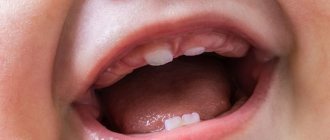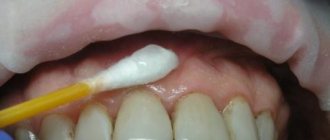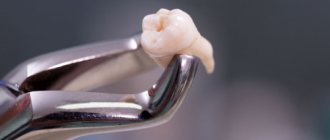When and in what order do baby teeth emerge?
For most children, the teething pattern looks like this:
- At 6-8 months, two central lower incisors appear.
- At 8-9 months, the upper central incisors.
- At 9-12 months, the upper lateral incisors erupt.
- At 11-12 months, the lower lateral incisors.
- At 12-15 months, the upper and lower molars.
- At 16-18 months, the upper canines
- At 18-20 months, the lower canines.
- Chewing teeth erupt at 2-3 years of age.
During normal development, baby teeth erupt in each area within 2-10 days, and the most unpleasant symptoms usually appear within 2-5 days. All 20 baby teeth erupt by age 3.
What to do if teeth are cut chaotically and behind schedule?
There is no need to sound the alarm right away. In some children, teething begins at 3 months, and in some at 10, and this is not a pathology, but a feature of the body. The same applies to the violation of the order of appearance of the incisors.
But if there is a delay of 3-5 months, you need to go for a consultation with a pediatrician or dentist.
The appearance of the first teeth is a natural physiological process, which at the same time can become a real test not only for the baby, but also for his parents. In many ways, the child’s condition at this moment depends on the positive attitude, support and attention from the parents. However, we should not forget about the whole arsenal of remedies that will help alleviate the unpleasant symptoms of teething and make this stage in life less exciting and painful.
Crying, whims, increased body temperature, lack of appetite, sleepless nights - all these are constant attributes of the period of dentition (teething) in children. Teething is a natural physiological process that begins at the age of 4-7 months and ends by 3 years, when All 20 baby teeth erupt. Despite the experience of generations, in reality, very few parents know what actually needs to be done to make life as easy as possible for both the baby and themselves.
You can recognize the imminent appearance of a baby tooth by the presence of characteristic signs:
The baby's gums become swollen and salivation increases - typically 4 days before the tooth erupts, on the day of teething, and 3 days after, leading to this 8-day window being called the "teething period".[1]
The child makes intense chewing movements with his gums, trying to get rid of the obsessive itching.
Often, children have a runny nose during the dental period. Nasal discharge and a rare wet cough during teething last no more than 3-5 days and are associated with increased mucus secretion and accumulation of saliva in the upper respiratory tract.
Fever during teething can last 1-2 days, and the child’s body temperature does not exceed 37.4-38⁰C. It is caused by the release of biologically active substances in the teeth growth zone and subsides on its own soon after eruption. However, if the child’s body temperature is above 38⁰C or lasts more than 2 days, you should consult a doctor.
Low-grade body temperature (37-38°C) in children SHOULD NOT be reduced with medication. If your baby's body temperature is above 38°C or lasts more than two days, consult a doctor immediately to rule out infection!
Digestive disorders and loss of appetite are also associated with a large volume of saliva secreted, which stimulates intestinal motility.
The child may become restless and irritable.
How to help your baby when teething
:
. At this moment, surround the child with care and affection - pick him up more often or rock him, thereby calming him down.
For itchy gums, use rubber teethers with liquid contents inside. Pay attention to the composition of the product - it should not contain bisphenol A, latex, PVC, phthalates.
Teethers ease the baby's discomfort from the appearance of the first baby teeth, develop thinking, concentrate attention, and improve fine motor skills of the fingers. Use safe “freezing” - before giving the teether to the child, place the
product in the refrigerator for an hour.
If you have already started feeding your baby, use nibblers (a silicone or mesh container with holes in which chewable foods are placed inside), or offer your baby chilled baby puree, yogurt, etc.
Try to learn a few simple techniques for massaging the gums with your finger to further help your child cope with the painful process of dental treatment.
Focus on safety
With all the introductions, it is, as a rule, almost impossible to overcome the pronounced painful symptoms during teething in a child without taking special medications. To help your baby without risking his health, you must follow the recommendations of your pediatrician. In this case, the choice should be made exclusively in favor of natural and safe products.
To alleviate the baby's condition during teething, parents quite often turn to dental gels based on local anesthetics (lidocaine, benzocaine, choline salicylate), unaware of the possible risks.
Local painkillers in gels have a short-term effect (no more than 1 hour), after which the pain returns. Trying to help their child, parents use gels more often than the safe dosing regimen allows. The natural result of excessive use of dental gels in infants is rapidly increasing intoxication, which can manifest itself as life-threatening symptoms, such as impaired breathing, swallowing, heart rhythm, etc.[2][3]
The Food and Drug Administration (FDA) in the United States opposes the use of lidocaine gels[4] for painful teething in children, warning of the risk of serious side effects.
The FDA has also banned the use of benzoin-based gels for teething in children.[5]
Such local anesthetic drugs numb the child’s gums for 10–20 minutes (in the oral cavity they are washed off with saliva and swallowed by the child), and the risks of their use outweigh the potential effect.
To help your baby without risking his health, you must follow the recommendations of your pediatrician. In this case, the choice should be made exclusively in favor of natural and safe products.
An oral solution based on medicinal plants (chamomile, laconosa, rhubarb) ─ Dantinorm Baby ─ is available in the form of individual dosed containers. Each container contains one 1 ml dose of a sterile solution of the drug, which can be easily dropped into the baby's mouth.
Unlike pain-relieving gels, the effect of Dantinorm Baby begins on average in 10 minutes and lasts on average 8 hours, which, when taken 3 times a day, protects the baby from teething symptoms 24 hours a day.[6] Over the many years of use of Dantinorm Baby throughout the world, not a single case of drug overdose has been reported and there have been no reports of side effects associated with its use.[7]
To date, Dantinorm Baby is the only drug used without restrictions for teething in infants, approved by the Russian Dental Association.
Expert opinion: Larisa Kiselnikova, head of the Department of Pediatric Dentistry, Moscow State Medical University named after. Evdokimova, chief freelance pediatric dentist in the Central Federal District of the Russian Ministry of Health.
“The Dental Association of Russia (StAR) constantly monitors the quality of products and medical products used in dental practice. In 2022, a special commission of StAR conducted an expert assessment of the documentation and analyzed foreign and Russian experience in using Dantinorm Baby. Based on the results of the inspection, the commission confirmed its high efficiency and safety.”
[1] Study Macknin ML, Piedmonte M, Jacobs J, Skibinski C. Symptoms associated with infant teething: a prospective study. Pediatrics. 2000: p. 747-752.
[2]Williams, Gary D., et al. "Salicylate intoxication from teething gel in infancy." Med J Aust 194.3 (2011): 146-8.
[3] https://www.gastroscan.ru/literature/authors/7390
[4]https://www.fda.gov/drugs/drug-safety-and-availability/fda-drug-safety-communication-fda-recommends-not-using-lidocaine-treat-teething-pain-and-requires #:~:text=In%20addition%20to%20causing%20death,or%20it%20is%20accidentally%20swallowed.
[5]https://www.fda.gov/news-events/press-announcements/fda-takes-action-against-use-otc-benzocaine-teething-products-due-serious-safety-risk-lack-benefit
[6] Kazyukova T.V., Ilyenko L.I., Kotlukov V.K. Duration and effectiveness of various medications for pathological symptoms of dentition in infants. Pediatrics. 2019; 98 (2): 133-140.
[7] Instructions for the drug Dantinorm Baby.
What are the common teething symptoms and what do you recommend?
- Profuse salivation.
One of the most obvious signs is when drool is literally flowing in a stream. Moreover, the symptom may appear a couple of months before the start of eruption.
Saliva should be carefully wiped away as it appears damp towel or napkin so as not to damage the skin. It is best to use wipes that contain xylitol - it prevents the growth of bacteria and the appearance of rashes on the skin.
- A strong desire to put everything in the mouth and chew.
Chewing helps your baby relieve the itching. The main thing is to hide objects that he could accidentally swallow or injure himself.
Lifehack. Bend your index finger and gently insert it into your baby's mouth. If he starts squeezing it with his gums, it means teeth are definitely coming out. If it just sucks, then it’s something else.
- Skin rashes.
A small rash on the cheeks or chin may occur due to skin contact with saliva. On irritated skin you just need to apply baby moisturizer.
ATTENTION! If the rash around the mouth appears without other symptoms of teething, it is better to show the child to the pediatrician!
- The baby cannot suckle normally.
At the peak of feeding, he abandons her and begins to act up. And sometimes he can bite with his gums. In such a situation, there is no need to force the child to eat. Even if he misses 2-3 feedings, nothing bad will happen. When he gets really hungry, he will still take the breast or bottle and eat. If you have no appetite for more than 24 hours, call a doctor.
- Redness and swelling of the gums.
It begins 2-5 days before teeth appear, goes away on its own, you don’t need to do anything.
You can also notice a blue bubble on the gum. This is a eruption hematoma. It occurs as a result of the destruction of small vessels in the gums during tooth eruption. It does not require any specific treatment. It will soon resolve on its own.
Additional recommendations
In addition to drug treatment, many methods can be used to relieve pain.
In addition to being attentive to the health and behavior of children, the following rules are observed:
- include raw carrots and apples in your diet;
- during teething, sleep next to mom;
- ventilate the children's room more often, especially during sleep;
- give plenty of fluids throughout the day, as they are lost through excessive salivation;
- to protect delicate skin from irritation due to a large amount of saliva, apply a moisturizer around the mouth, on the cheeks, neck and chin;
- pay more attention, play outside in the fresh air, at home with toys;
- hold vertically, which will help reduce blood circulation in the painful area;
- monitor the air temperature, do wet cleaning in the room and ventilate it;
- at the age of approximately 1-1.5 years, you can purchase a silicone brush;
- take vitamin complexes prescribed by the doctor;
- when breastfeeding, it is recommended to feed more often on demand;
- do not allow sweets and chocolate on the menu, because sugar and starch are a source of food for pathogenic bacteria.
Help during the appearance of baby teeth
What are the complications, and when to see a doctor?
| Symptom | Teeth are being cut, there is no need to go to the pediatrician | The disease develops, contact your pediatrician |
| Cough | A coughing attack begins due to excess salivation. The cough is wet and infrequent. | The cough gets worse, does not go away, does not allow the baby to sleep, and prevents him from eating. Doesn't stop for more than 2 days. Breathe heavily. |
| Nasal discharge | Nasal discharge is transparent and watery and disappears by the 4th day. | The runny nose does not go away for the 4th day. Lots of yellow or green discharge. |
| Heat | The temperature does not exceed 38 °C and lasts no more than 2-3 days. Rapidly decreases under the influence of antipyretics. | Fever above 38.5 °C for more than 2 days. Signs of a cold appear (severe cough and runny nose). |
| Loose stools | Lasts less than 72 hours. | Lasts more than 72 hours. |
| Changes in the oral cavity | The gums become swollen and red. | The oral mucosa is covered with white plaque or ulcers. |
Reasons why a baby may have missing teeth:
- delayed physical development (rickets);
- absence of organ rudiments (edentia);
- lack of phosphorus, calcium, vitamin C, D and retinol;
- decreased thyroid activity (hypothyroidism).
Some children are born with a number of “white islands”. Doctors advise removing them so that the mother can freely feed the baby with breast milk. The first molar can come out at 4 months, but this may be a sign of a malfunction of the endocrine system.
What can be done to help a child with severe itching and pain?
- Carry your baby in your arms more often, play with him and distract him.
- Give chilled water in a bottle, cool fruit puree or kefir. The main thing is that the liquid is not too cold, otherwise the baby will catch a cold.
- Massage the gums with a special silicone brush (see picture above) or you can gently use your clean finger.
- Buy your baby a teether and let's chew.
Such devices are made from plastic, rubber, silicone, wood, or a combination of different materials. The surface of the toys should be elastic and uneven to make it easier for the child to scratch the gums. A cooled teether relieves itching better, so it can be placed in the refrigerator to cool for 10-15 minutes. But don't chill it in the freezer!
- Do not use gum gels with lidocaine and benzocaine.
The child has a lot of saliva in the mouth, so gels are not effective during this period. The child swallows most of the gel.
Help at night
The pain becomes especially severe at night. If sleep is disturbed, the baby constantly cries and is capricious. An integrated approach will help to cope with the problem.
First of all, they take him in their arms. Apply a special preparation to the gums and measure the temperature. Use chilled teethers or water with a pacifier in a bottle.
To avoid nighttime whims, it is recommended:
- before bed, take a herbal bath of chamomile or string;
- feed and give water;
- Apply the pain-relieving gel prescribed by the doctor to painful areas;
- calm down, sing a lullaby, carry in your arms if necessary;
- ventilate the nursery, create comfortable conditions for sleeping.
A pillow should be placed in the baby's bed so that due to the high position of the head, less blood flows into the gum area. For this purpose, raise the mattress slightly at the head of the bed.
Recommendations! Many fathers and mothers do not want to accustom their children to holding hands, but do not be afraid of this, because at such a difficult stage, infants need special support and help.
How to improve your baby's sleep
What should you not do when your baby is teething?
- Strongly touch the child’s gums with your fingers, press on them and pick them out. This can increase pain or cause infection.
- Conduct vaccination, because immune system is weakened during this period .
- Without supervision, allow your child to chew any hard foods that could cause choking.
- Give homeopathic remedies. Not only will they not help the child, but they can cause serious harm.
The eruption of baby teeth is not a problem, but a natural process for a child’s body. But if you are not sure about something, do not hesitate to ask specialists. If you have any questions, write to us on Instagram.
Traditional methods
The natural period in the life of a little person is made easier with the help of folk recipes.
Warm herbal tea
Discomfort in the gums and itching are relieved by decoctions of medicinal herbs. Chamomile, lemon balm, lavender, mint are suitable for the recipe. Pour 1 tablespoon of dry plant into a glass of boiling water and leave for 20-30 minutes. The prepared drink is given instead of water; it is useful for breastfeeding mothers to drink.
Clove oil
Clove oil quickly relieves the condition, which before use is diluted with any base vegetable oil in a 1:1 ratio. The product is rubbed into the painful area.
Soda solution
Swollen areas are wiped with a piece of bandage or cloth soaked in a baking soda solution. It is important to perform the procedure with sterile hands.
Sage decoction
A herbal decoction of sage is rubbed into the hard area. The folk remedy will not only soothe swollen tissues, but also strengthen the enamel. The decoction is also added to the baby's bath during bathing.
Mumiyo
Shilajit, a natural product with a powerful healing effect, has been used for a long time.
Natural honey
If you are not allergic to honey, then wipe your gums with a piece of the solid product. The procedure is carried out with light rubbing movements.
Valerian
A compress made from valerian extract helps relieve anxiety and pathological symptoms.
Solid food
Solid foods help distract from the problem. You can give a cold apple or carrot to chew on, but you need to be careful so that a large piece of the vegetable or fruit does not break off. A piece of dry bread, or its crust, or cookies will do.
Don't forget about the local effects of cold. Both special silicone and plastic products with liquid inside, as well as cooled silicone objects and toys are suitable for this.
Recommendations! If a child is teething, the doctor will always tell you how to numb the pain. If there are contraindications to drug treatment, folk remedies will always come to the rescue.
Solid Vegetables for Baby Gums
Symptoms of the appearance of primary incisors
It is difficult to say exactly how long it takes for a child to cut his first teeth, however, parents should know the signs of the appearance of “white islands”. The process of molar growth is accompanied by the following symptoms:
- swelling of the gums;
- excessive salivation;
- tearfulness, irritability;
- low-grade fever;
- sucking foreign objects.
Teething causes anxiety for the baby, manifested by bad mood and constant crying. Due to severe pain, the child sometimes refuses to eat.
Attention! An elevated temperature is not a necessary sign of the appearance of painters; if it does not rise above 37.5 degrees, there is no need to worry. With higher levels, there is a risk of developing a cold due to weak immunity.
How long does it take to transform a smile?
How long it takes for the first tooth to be cut primarily depends on the characteristics of the baby’s body. First, the gums swell - the first stage. From this moment it may take up to 2 months until the first child appears.
The process of cutting through the painter itself can take from 3 to 7 days. At this time, the crumbs constantly drag everything into their mouths, pressing on the problem area, they relieve the pain. A gentle massage of the gums will help eliminate unpleasant discomfort.
You can use a massager, which can be easily purchased in a network of pharmacies and stores. Gels with benzocaine and lidocaine also help reduce the intensity of discomfort. But first you need to make sure that your baby is not allergic to the active components of painkillers.
Before using the gel, it is recommended to place it in the cold, thanks to which blood circulation is delayed and pain is reduced.










